- Home
- Philip K. Dick
Confessions of a Crap Artist
Confessions of a Crap Artist Read online
Philip K. Dick
CONFESSIONS OF A
CRAP ARTIST
PHILIP K. DICK was born in Chicago in 1928 and lived most of his life in California. He briefly attended the University of California, but dropped out before completing any classes. In 1952 he began writing professionally and proceeded to write thirty-six novels and five short story collections. He won the Hugo Award for best novel in 1962 for The Man in the High Castle and the John W. Campbell Memorial Award for best novel of the year in 1974 for Flow My Tears the Policeman Said. Philip K. Dick died of heart failure following a stroke on March 2,1982, in Santa Ana, California.
ALSO BY PHILIP K. DICK,
AVAILABLE FROM VINTAGE BOOKS
The Divine Invasion
The Game-Players of Titan
The Man in the High Castle
A Scanner Darkly
The Three Stigmata of Palmer Eldritch
The Transmigration of Timothy Archer
Ubik
VALIS
To Tessa,
the dark-haired girl who cared about me
when it mattered most; that is, all the time.
This is to her with love.
1
I am made out of water. You wouldn't know it, because I have it bound in. My friends are made out of water, too. All of them. The problem for us is that not only do we have to walk around without being absorbed by the ground but we also have to earn our livings.
Actually there's even a greater problem. We don't feel at home anywhere we go. Why is that?
The answer is World War Two.
World War Two began on December 7, 1941. In those days I was sixteen years old and going to Seville High. As soon as I heard the news on the radio I realized that I was going to be in it, that our president had his opportunity now to whip the Japs and the Germans, and that it would take all of us pulling shoulder to shoulder. The radio was one I built myself. I was always putting together superhet five-tube ac-dc receivers. My room was overflowing with earphones and coils and condensers, along with plenty of other technical equipment.
The radio announcement interrupted a bread commercial that went:
“Homer! Get Homestead bread instead!”
I used to hate that commercial, and I had just jumped up to turn to another frequency when all at once this woman's voice was cut off. Naturally I noticed that; I didn't have to think twice to be aware that something was up. Here I had my German colonies stamps—those that show the Kaiser's yacht the Hohenzollern—spread out only a little way from the sunlight, and I had to get them mounted before anything happened to them. But I stood in the middle of my room doing absolutely nothing except respiring, and, of course, keeping other normal processes going. Maintaining my physical side while my mind was focused on the radio.
My sister and mother and father, naturally, had gone away for the afternoon, so there was nobody to tell. That made me livid with rage. After the news about the Jap planes dropping bombs on us, I ran around and around, trying to think who to call up. Finally I ran downstairs to the living room and phoned Hermann Hauck, who I went around with at Seville High and who sat next to me in Physics 2A. I told him the news, and he came right over on his bicycle. We sat around listening for further word, discussing the situation.
While discussing, we lit up a couple of Camels.
“This means Germany and Italy'll get right in,” I told Hauck. “This means war with the Axis, not just the Japs. Of course, we'll have to lick the Japs first, then turn our attention to Europe.”
“I'm sure glad to see our chance to clobber those Japs,” Hauck said. We both agreed with that. “I'm itching to get in,” he said. We both paced around my room, smoking and keeping our ears on the radio. “Those crummy little yellow-bellies,” Hermann said. “You know, they have no culture of their own. Their whole civilization, they stole it from the Chinese. You know, they're actually descended more from apes; they're not actually human beings. It's not like fighting real humans.”
“That's true,” I said.
Of course, this was back in 1941, and an unscientific statement like that didn't get questioned. Today we know that the Chinese don't have any culture either. They went over to the Reds like the mass of ants that they are. It's a natural life for them. Anyhow it doesn't really matter, because we were bound to have trouble with them sooner or later anyhow. We'll have to lick them someday like we licked the Japs. And when the time comes we'll do it.
It wasn't long after December 7 that the military authorities put up the notices on the telephone poles, telling Japs that they had to be out of California by such and such a date. In Seville—which is about forty miles south of San Francisco—we had a number of Japs doing business; one ran a flower nursery, another had a grocery store—the usual smalltime businesses that they run, cutting pennies here and there, getting their ten kids to do all the work, and generally living on a bowl of rice a day. No white person can compete with them because they're willing to work for nothing. Anyhow, now they had to get out whether they liked it or not. In my estimation it was for their own good anyhow, because a lot of us were stirred up about Japs sabotaging and spying. At Seville High a bunch of us chased a Jap kid and kicked him around a little, to show how we felt. His father was a dentist, as I recall.
The only Jap that I knew at all was a Jap who lived across the street from us, an insurance salesman. Like all of them, he had a big garden out on the sides and rear of his house, and in the evenings and on weekends he used to appear wearing khaki pants, a t-shirt, and tennis shoes, with an armload of garden hose and a sack of fertilizer, a rake and a shovel. He had a lot of Jap vegetables that I never recognized, some beans and squash and melons, plus the usual beets and carrots and pumpkins. I used to watch him scratching out the weeds around the pumpkins, and I'd always say:
“There's Jack Pumpkinhead out in his garden, again. Searching for a new head.”
He did look like Jack Pumpkinhead, with his skinny neck and his round head; his hair was shaved, like the college students have theirs, now, and he always grinned. He had huge teeth, and his lips never covered them.
The idea of this Jap wandering around with a rotting head, in search of a fresh head, used to dominate me, back at that time before the Japs were moved out of California. He had such an unhealthy appearance—mostly because he was so thin and tall and stooped—that I conjectured as to what ailed him. It looked to me to be t.b. For a while I had the fear— it bothered me for weeks—that one day he'd be out in the garden, or walking down his path to get into his car, and his neck would snap and his head would bounce off his shoulders and roll down to his feet. I waited in fear for this to happen, but I always had to look out when I heard him. And whenever he was around I could hear him, because he continually hawked and spat. His wife spat too, and she was very small and pretty. She looked almost like a movie star. But her English, according to my mother, was so bad that there was no use of anybody trying to talk to her; all she did was giggle.
The notion that Mr. Watanaba looked like Jack Pumpkinhead could never have occurred to me if I hadn't read the Oz books in my younger years; in fact I still had a few of them around my room as late as World War Two. I kept them with my science-fiction magazines, my old microscope and rock collection, and the model of the solar system that I had built in junior high school for science class. When the Oz books were first written, back around 1900, everybody took them to be completely fiction, as they did with Jules Verne's books and H.G. Wells'. But now we're beginning to see that although the particular characters, such as Ozma and the Wizard and Dorothy, were all creations of Baum's mind, the notion of a civilization inside the world is not such a fantastic one. Recently, Richard Shaver has given
a detailed description of a civilization inside the world, and other explorers are alerted for similar finds. It may be, too, that the lost continents of Mu and Atlantis will be found to be part of the ancient culture of which the interior lands played a major role.
Today, in the 1950s, everyone's attention is turned upward, to the sky. Life on other worlds preoccupies people's attention. And yet, any moment, the ground may open up beneath our feet, and strange and mysterious races may pour out into our very midst. It's worth thinking about, and out in California, with the earthquakes, the situation is particularly pressing. Every time there's a quake I ask myself: is this going to open up the crack in the ground that finally reveals the world inside? Will this be the one?
Sometimes at the lunch hour break, I've discussed this with the guys I work with, even with Mr. Poity, who owns the firm. My experience has been that if any of them are conscious of non-terrestrial races at all, they're concerned only with UFOs, and the races we're encountering, without realizing it, in the sky. That's what I would call intolerance, even prejudice, but it takes a long time, even in this day and age, for scientific facts to become generally known. The mass of scientists themselves are slow to change, so it's up to us, the scientifically-trained public, to be the advance guard. And yet I've found, even among us, there are so many that just don't give a damn. My sister, for instance. During the last few years she and her husband have been living up in the north western part of Marin County, and all they seem to care about up there is Zen Buddhism. And so here's an example, right in my own family, of a person who has turned from scientific curiosity to an Asiatic religion that threatens to submerge the questioning rational faculty as surely as Christianity.
Anyhow, Mr. Poity takes an interest, and I've loaned him a few of the Col. Churchward books on Mu.
My job with the One-Day Dealers' Tire Service is an interesting one, and it makes some use of my skill with tools, although little use of my scientific training. I'm a tire regroover. What we do is pick up smoothies, that is, tires that are worn down so they have little or no tread left, and then I and the other regroovers take a hot point and groove right down to the casting, following the old tread pattern, so it looks as if there's still rubber on the tire—whereas in actual fact there's only the fabric of the casing left. And then we paint the regrooved tire with black rubbery paint, so it looks like a pretty darn good tire. Of course, if you have it on your car and you so much as back over a warm match, then boom! You have a flat. But usually a regrooved tire is good for a month or so. You can't buy tires like I make, incidentally. We deal wholesale only, that is, with used car lots.
The job doesn't pay much, but it's sort of fun, figuring out the old tread pattern—sometimes you can scarcely see it. In fact, sometimes only an expert, a trained technician like myself, can see it and trace it. And you have to trace perfectly, because if you leave the old tread pattern, there's a huge gouge mark that even an idiot can recognize as not having been made by the original machine. When I get done re-grooving a tire, it doesn't look hand-done by any means. It looks exactly like the way it would look if a machine had done it, and, for a regroover, that's the most satisfying feeling in the world.
2
Seville, California, has a good public library. But the best thing about living in Seville is that in only a twenty-minute drive you're over into Santa Cruz where the beach is and the amusement park is. And it's four lanes all the way.
To me, though, the library has been important in forming my education and convictions. On Fridays, which is my day off, I go down around ten in the morning and read Life and the cartoons in the Saturday Evening Post, and then if the librarians aren't watching me, I get the photography magazines from the rack and read them over for the purpose of finding those special art poses that they have the girls doing. And if you look carefully in the front and back of the photography magazines, you find ads that nobody else notices, ads there for you. But you need to be familiar with the wording. Anyhow, what those ads get you, if you send in the dollar, is something different from what you see even in the best magazines, like Playboy or Esquire. You get photos of girls doing something else entirely, and in some ways they're better, although usually the girls are older—sometimes even baggy old hags—and they're never pretty, and, worst of all, they have big fat saggy breasts. But they are doing really unusual things, things that you'd never ordinarily expect to see girls do in pictures—not especially dirty things, because after all, these come through the Federal mails from Los Angeles and Glendale—but things such as one I remember in which one girl was lying down on the floor, wearing a black lace bra and black stockings and French heels, and this other girl was mopping her all over with a mop from a bucket of suds. That held my attention for months. And then there was another I remember, of a girl wearing the usual—as above—pushing another girl similarly attired down a ladder so that the victim-girl (if that's what you call it; at least, that's how I usually think of it) was all bent and lopsided, as if her arms and legs were broken—like a rag doll or something, as if she's been run over.
And then always there's the ones you get in which the stronger girl, the master, has the other tied up. Bondage pictures, they're called. And better than that are the bondage drawings. They're really competent artists who draw those … some are really worth seeing. Others, in fact most of them, are the run-of-the-mill junk, and really shouldn't be allowed to go through the mails, they're so crude.
For years I've had a strange feeling looking at these pictures, not a dirty feeling—nothing to do with sexuality or relations—but the same feeling you get when you're high up on a mountain, breathing that pure air, the way it is over by Big Basin Park, where the redwoods are, and the mountain streams. We used to go hunting around in those redwoods, even though naturally it's illegal to hunt in a state or Federal park. We'd get a couple of deer, now and then. The guns we used weren't mine, though. I borrowed the one I used from Harvey St. James.
Usually when there's anything worth doing, all three of us, myself and St. James and Bob Paddleford, do it together, using St. James' '57 Ford convertible with the double pipes and twin spots and dropped rear end. It's quite a car, known all around Seville and Santa Cruz; it's gold-colored, that baked on enamel, with purple trim that we did by hand. And we used molded fiberglass to get those sleek lines. It looks more like a rocket ship than a car; it has that look of outer space and velocities nearing the speed of light.
For a really big time, where we go is across the Sierras to Reno; we leave late Friday, when St. James gets off from his job selling suits at Hapsberg's Menswear, shoot over to San Jose and pick up Paddleford—he works for Shell Oil, down in the blueprint department—and then we're off to Reno. We don't sleep Friday night at all; we get up there late and go right to work playing the slots or blackjack. Then around ten o'clock Saturday morning we take a snooze in the car, find a washroom to shave and change our shirts and ties, and then we're off looking for women. You can always find that kind of women around Reno; it's really a filthy town.
I actually don't enjoy that part too much. It plays no role in my life, any more than any other physical activity. Even to look at me you'd recognize that my main energies are in the mind.
When I was in the sixth grade I started wearing glasses because I read so many funny books. Tip Top Comics and King Comics and Popular Comics … those were the first comic books to appear, back in the mid 'thirties, and then there were a whole lot more. I read them all, in grammar school, and traded them around with other kids. Later on, in junior high, I started reading Astonishing Stories, which was a pseudo-science magazine, and Amazing Stories, and Thrilling Wonder. In fact, I had an almost complete file of Thrilling Wonder, which was my favorite. It was from an ad in Thrilling that I got the lucky lodestone that I still carry around with me. That was back around 1939.
All my family have been thin, my mother excepted, and as soon as I put on those silver-framed glasses they always gave to boys in those days, I immediatel
y looked scholarly, like a real bookworm. I had a high forehead anyhow. Then later, in high school, I had dandruff to quite an extent. And this made my hair seem lighter than it actually was. Once in a while I had a stammer that bothered me, although I found that if I suddenly bent down, as if brushing something from my leg, I could speak the word okay, so I got in the habit of doing that. I had, and still have, an indentation on my cheek, by my nose, left over from having had the chicken pox. In high school I felt nervous a great deal of the time, and I used to pick at it until it became infected. Also, I had other skin troubles, of the acne type, although in my case the spots got a purple texture that the dermatologist said was due to some low-grade infection throughout my body. As a matter of fact, although I'm thirty-four, I still break out in boils once in a while, not on my face but on my butt or armpits.
In high school I had some nice clothes, and that made it possible for me to step out and be popular. In particular I had one blue cashmere sweater that I wore for almost four years, until it got to smelling so bad the gym instructor made me throw it away. He had it in for me anyhow, because I never took a shower in gym.
It was from the American Weekly, not from any magazines, that I got my interest in science.
Possibly you remember the article they had, in the May 4th, 1935 issue, on the Sargasso Sea. At that time I was ten years old, and in the high fourth. So I was just barely old enough to read something besides funny books. There was a huge drawing, in six or seven colors, that covered two whole opened-up pages; it showed ships, stuck in the Sargasso Sea, that had been there for hundreds of years. It showed the skeletons of the sailors, covered with seaweed. The rotting sails and masts of the ships. And all different kinds of ships, even some ancient Greek and Roman ones, and some from the time of Columbus, and then the Norsemen's ships. Jumbled in together. Never stirring. Stuck there forever, trapped by the Sargasso Sea.

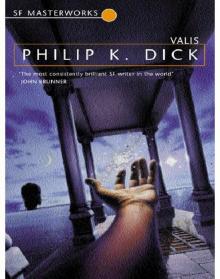 Valis
Valis The Simulacra
The Simulacra In Milton Lumky Territory
In Milton Lumky Territory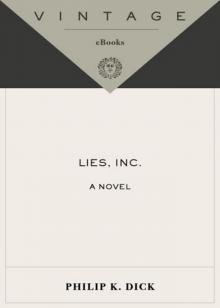 Lies, Inc.
Lies, Inc. The Man Who Japed
The Man Who Japed Selected Stories of Philip K. Dick
Selected Stories of Philip K. Dick Gather Yourselves Together
Gather Yourselves Together Beyond the Door
Beyond the Door Our Friends From Frolix 8
Our Friends From Frolix 8 Do Androids Dream of Electric Sheep?
Do Androids Dream of Electric Sheep?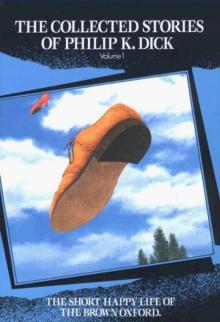 The Short Happy Life of the Brown Oxford and Other Classic Stories
The Short Happy Life of the Brown Oxford and Other Classic Stories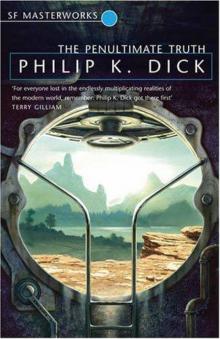 The Penultimate Truth
The Penultimate Truth Counter-Clock World
Counter-Clock World The Minority Report: 18 Classic Stories
The Minority Report: 18 Classic Stories Now Wait for Last Year
Now Wait for Last Year The Broken Bubble
The Broken Bubble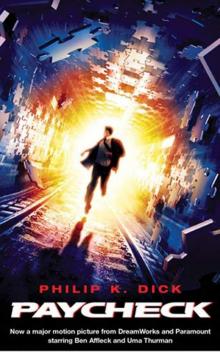 Paycheck
Paycheck Ubik
Ubik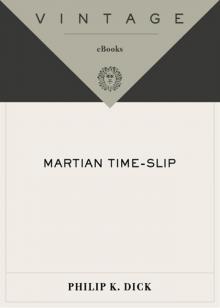 Martian Time-Slip
Martian Time-Slip The Shifting Realities of Philip K. Dick
The Shifting Realities of Philip K. Dick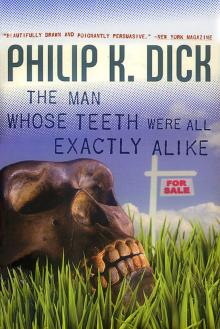 The Man Whose Teeth Were All Exactly Alike
The Man Whose Teeth Were All Exactly Alike Mary and the Giant
Mary and the Giant The Man in the High Castle
The Man in the High Castle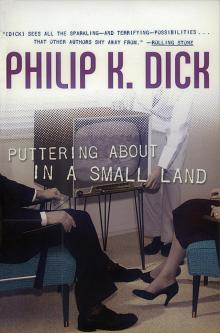 Puttering About in a Small Land
Puttering About in a Small Land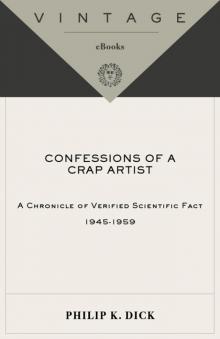 Confessions of a Crap Artist
Confessions of a Crap Artist Mr. Spaceship by Philip K. Dick, Science Fiction, Fantasy, Adventure
Mr. Spaceship by Philip K. Dick, Science Fiction, Fantasy, Adventure Nick and the Glimmung
Nick and the Glimmung Deus Irae
Deus Irae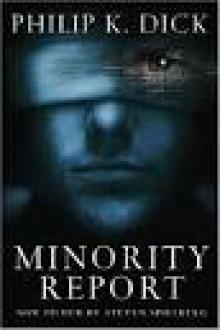 The Minority Report
The Minority Report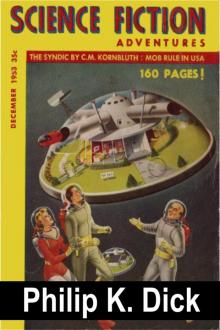 The Hanging Stranger
The Hanging Stranger The Variable Man
The Variable Man Voices From the Street
Voices From the Street Second Variety and Other Stories
Second Variety and Other Stories A Scanner Darkly
A Scanner Darkly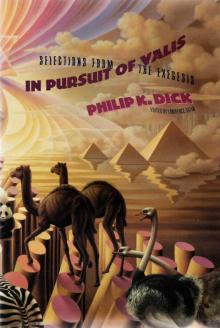 In Pursuit of Valis
In Pursuit of Valis The Three Stigmata of Palmer Eldritch
The Three Stigmata of Palmer Eldritch The Transmigration of Timothy Archer
The Transmigration of Timothy Archer The Crack in Space
The Crack in Space The Collected Stories of Philip K. Dick 3: Second Variety
The Collected Stories of Philip K. Dick 3: Second Variety The Collected Stories of Philip K. Dick 4: The Minority Report
The Collected Stories of Philip K. Dick 4: The Minority Report The Skull
The Skull Solar Lottery
Solar Lottery Vulcan's Hammer
Vulcan's Hammer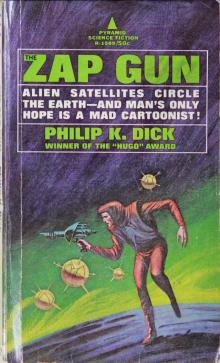 The Gun
The Gun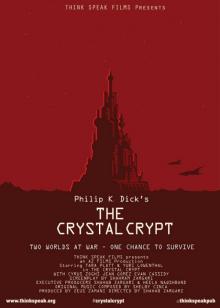 The Crystal Crypt
The Crystal Crypt The Collected Stories of Philip K. Dick 5: The Eye of the Sibyl
The Collected Stories of Philip K. Dick 5: The Eye of the Sibyl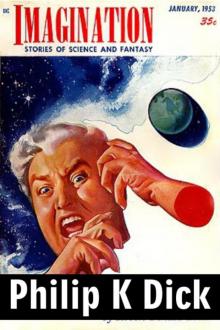 Mr. Spaceship
Mr. Spaceship The Zap Gun
The Zap Gun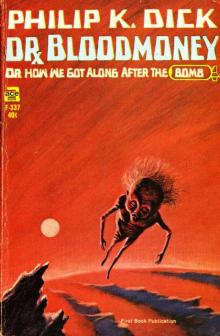 Dr. Bloodmoney
Dr. Bloodmoney Beyond Lies the Wub
Beyond Lies the Wub Galactic Pot-Healer
Galactic Pot-Healer The Divine Invasion
The Divine Invasion Radio Free Albemuth
Radio Free Albemuth A Maze of Death
A Maze of Death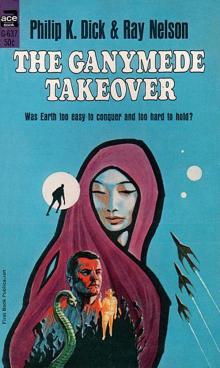 The Ganymede Takeover
The Ganymede Takeover The Philip K. Dick Reader
The Philip K. Dick Reader The Exegesis of Philip K. Dick
The Exegesis of Philip K. Dick The Complete Stories of Philip K. Dick Vol. 4:
The Complete Stories of Philip K. Dick Vol. 4: Tony and the Beetles
Tony and the Beetles The Cosmic Puppets
The Cosmic Puppets The Complete Stories of Philip K. Dick Vol. 5: The Eye of the Sibyl and Other Classic Stories
The Complete Stories of Philip K. Dick Vol. 5: The Eye of the Sibyl and Other Classic Stories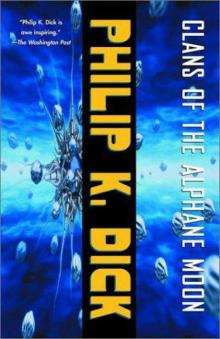 Clans of the Alphane Moon
Clans of the Alphane Moon Flow My Tears, the Policeman Said
Flow My Tears, the Policeman Said The World Jones Made
The World Jones Made Total Recall
Total Recall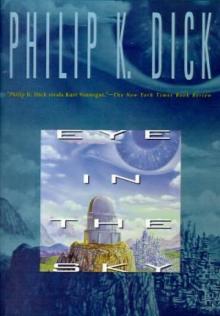 Eye in the Sky
Eye in the Sky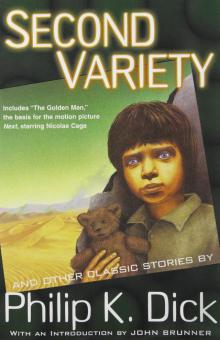 Second Variety
Second Variety Vintage PKD
Vintage PKD A Handful of Darkness
A Handful of Darkness Complete Stories 3 - Second Variety and Other Stories
Complete Stories 3 - Second Variety and Other Stories The Book of Philip K Dick
The Book of Philip K Dick The Transmigration of Timothy Archer (Valis)
The Transmigration of Timothy Archer (Valis) Autofac
Autofac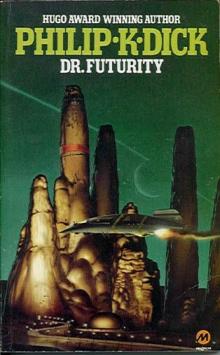 Dr. Futurity (1960)
Dr. Futurity (1960)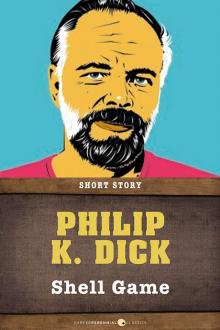 Shell Game
Shell Game The Minority Report and Other Classic Stories
The Minority Report and Other Classic Stories Collected Stories 2 - Second Variety and Other Classic Stories
Collected Stories 2 - Second Variety and Other Classic Stories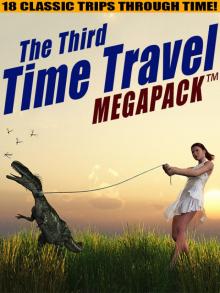 The Third Time Travel
The Third Time Travel The Game-Players Of Titan
The Game-Players Of Titan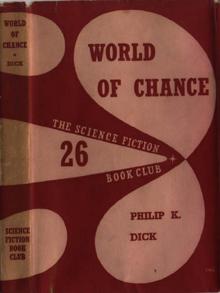 World of Chance
World of Chance The Shifting Realities of PK Dick
The Shifting Realities of PK Dick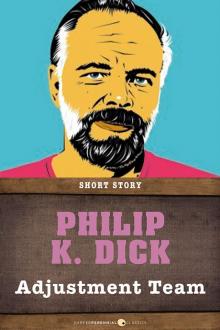 Adjustment Team
Adjustment Team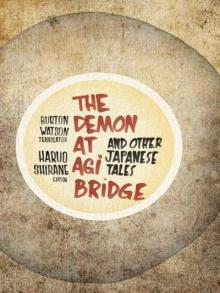 The Demon at Agi Bridge and Other Japanese Tales (Translations from the Asian Classics)
The Demon at Agi Bridge and Other Japanese Tales (Translations from the Asian Classics) Collected Stories 3 - The Father-Thing and Other Classic Stories
Collected Stories 3 - The Father-Thing and Other Classic Stories CANTATA-141
CANTATA-141 The Adjustment Team
The Adjustment Team The Collected Stories of Philip K Dick
The Collected Stories of Philip K Dick Electric Dreams
Electric Dreams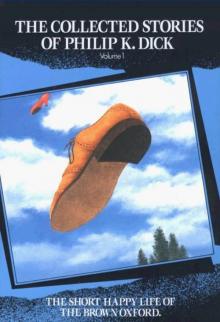 Collected Stories 1 - The Short Happy Life of the Brown Oxford and Other Classic Stories
Collected Stories 1 - The Short Happy Life of the Brown Oxford and Other Classic Stories Eye in the Sky (1957)
Eye in the Sky (1957)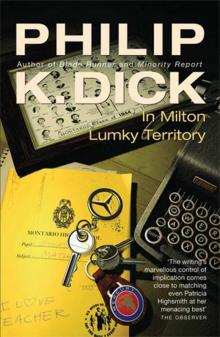 In Milton Lumky Territory (1984)
In Milton Lumky Territory (1984) The VALIS Trilogy
The VALIS Trilogy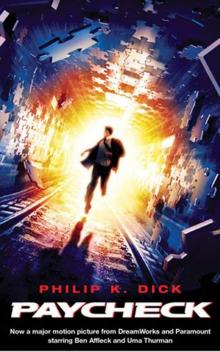 Paycheck (2003)
Paycheck (2003) The Unteleported Man
The Unteleported Man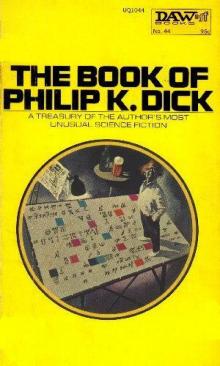 The Book of Philip K Dick (1973)
The Book of Philip K Dick (1973) Collected Stories 5 - The Eye of the Sibyl and Other Classic Strories
Collected Stories 5 - The Eye of the Sibyl and Other Classic Strories The Eye of the Sibyl and Other Classic Strories
The Eye of the Sibyl and Other Classic Strories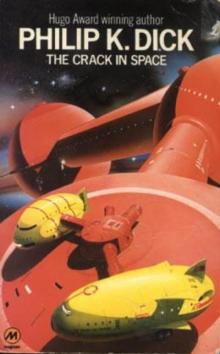 The Crack in Space (1966)
The Crack in Space (1966)